The goal is to learn to distinguish the letters A-Z by ear and in writing.
Tasks:
Correctional and educational:
- Improve knowledge about vowels of the first row and the formation of vowels of the second row;
- Learn to distinguish between hard and soft consonants before vowels A-Z;
- Learn to differentiate the letters A-Z by ear and in writing at the level of syllables, words, phrases and sentences;
- Consolidate knowledge about the mechanism of writing the letters “a” and “z”, their graphic features;
- Replenish and activate the dictionary.
Correctional and developmental:
- develop spatial concepts;
- develop auditory attention, phonemic perception;
- consolidate the skill of synthesizing the letters “a” and “i” from their elements;
- develop phonemic synthesis skills;
- develop VPF;
- develop communication skills.
Corrective education:
- cultivate hard work;
- cultivate a sense of mutual assistance;
- cultivate goodwill;
- develop the skill of self-control;
- develop adequate self-esteem.
Equipment: Anya doll, table of vowel sounds, images of lowercase and uppercase letters A-Z, workbooks, task cards.
Progress of the lesson.
- Organizing time.
— Today a girl with a magical name came to our lesson. Her name is Anya. What do you think, children, what is special about our guest’s name? (the fact that it can be read from left to right and right to left)
- Exactly right!
— What is the first letter of the girl’s name (A), and what is the last letter? (I).
- Fine. Look at the vowel chart. How many rows does it have? (2 rows of vowels) Look, what color are the sounds of the first row? (in red) Which of our sounds is in this row? (A)
— What colors indicate the vowels of the second row? (green and red) Explain why the vowels of the 2nd row are indicated in two colors? (because they can represent 2 sounds)
- That's right, vowels of the second row are formed with the help of [th] and vowels of the first row. But these vowels designate 2 sounds only in those cases if they are at the beginning of a word, if they are after vowels, and if they are after -ь- and –ъ-. Which of the vowels we need is in the second row? (I)
- Children, do you want to know how many sounds the letter I represents in the words Anya and Yana? (Yes)
- Let's put these names in sound outfits then.
-How many sounds does the letter I represent in the word Anya? (one)
— How many sounds does the letter I represent in the word Yana? (two) Why? (because it comes at the beginning of the word.)
- Well done! So, the vowels A-Z are called paired. In order not to confuse them when writing, we will learn to distinguish between them.
- Main part.
- "True False"
Check the box next to the correct statement; if the statement is false, put a dash.
- The vowels o, a, u, y, e indicate the softness of the previous consonant,
- The vowels e, e, i, yu, i indicate the softness of the previous consonant,
- The letter a denotes the vowel sound [a] and indicates the hardness of the previous consonant,
- The letter i denotes the vowel sound [я] and indicates the hardness of the previous consonant,
- The letter i denotes the vowel sound [a] and indicates the softness of the previous consonant
- Visual analysis of the letters “a” and “z”, determining their similarities and differences.
Lowercase and uppercase letters A-Z are displayed on the board.
- Look at the letter “a”. What elements does the letter “a” consist of? (The letter “a” consists of an oval and a hook, which is located to the right of the oval) - the elements of the letter “a” are written on the board).
– What about the letter “I”? (The letter “I” consists of a circle and an element that is located to the right of the circle, and an element that goes down - the elements of the letter “I” are written on the board).
– So, how are the letters “a” and “i” similar? (Both letters have an element - a hook)
– How are these letters different?
– Now let’s write the handwritten lowercase letters “a” and “i” in the air.
(Children write handwritten lowercase letters “a” and “z” in the air).
- Differentiation of letters A-Z at the syllable level.
Listen, memorize and repeat the series of syllables. One row each in a chain.
Ta-ta-ta-ta
Rya - ra - ra - rya
Nya - na - na - nya
Me - ma - me - me - ma
Ba-bya-ba-ba-bya.
- Development of phonemic synthesis.
- Now, guys, let's collect words from letters and read them. What words did you come up with?
d, d, i, i z, m, l, e, i n, n, i, i,
k, r, t, o, a, n d, b, g, o, i, r, a k, r, i, a, o, g
(snag, nanny, tramp, earth, uncle, cardboard)
- Physical education minute.
"Apple"
Reach out your hand and pick an apple.
The wind began to shake the apple tree,
It's hard to pick an apple.
I’ll jump up and extend my hand -
I'll quickly pick an apple.
- Differentiation of letters A-Z at the word level.
Complete the words by adding the letter A or Z.
Mish__, fish__, earth__, grass__, family__, mountains__, sea__, Women__.
-What color do we use to indicate the consonants that precede the letters A-Z? Emphasize them.
- Differentiation of letters A-Z at the level of phrases
“They sent us a magical message, but we can read it only when we insert the missing letters into the words and select the appropriate word from the right column for each of the left columns.”
TINY B...BARREL...
SMART MOUSE…
FURRY SNAKE…
GRAY MONKEY...N...
POISONOUS CAT...
BRIGHT FOX…
- Differentiation of letters A–Z at the sentence level.
Write the sentences in your notebook, inserting the missing letters A-Z.
An__, Kat__ and Ir__ played f____.
- Lesson summary:
– What letters did we learn to distinguish today? (Vowels “a” and “ya”).
– What do they have in common? (Vowels)
– How do the letters “a” and “i” differ? (Consonants before the vowel “a” sound hard, and before the vowel “ya” they sound soft).
– You did a very good job in class. I hope that now you will never confuse the letters “a” and “i” in writing.
Russian language lesson on the topic: Hard and soft sounds and letters to denote them"
Lesson in the Russian language on the topic “Hard and soft sounds and letters for their designation.” 2nd grade
Topic:
“Hard and soft consonant sounds and letters to denote them”
Purpose:
repeat ways of indicating the softness of consonant sounds in writing.
Tasks:
Improve the ability to identify and distinguish between hard and soft consonants.
develop students’ speech hearing, establish ways to indicate the softness of consonants in writing, paired and unpaired consonant sounds in terms of hardness and softness
Instill interest in the Russian language.
Planned results:
Students will learn:
Identify and differentiate between hard and soft consonants.
Identify and differentiate vowels of rows 1 and 2.
Learn the depths of the Russian language.
Metasubject:
develop the ability to determine the topic of the lesson; learn to work in pairs and groups.
Personal:
develop the ability to listen and hear, express correctly and
prove your opinion, answer reasonedly, prove your opinion, respect the opinion of your classmates.
Equipment:
Russian language textbook by V.P. Kanakina, ICT, cards for individual work, cards for work in groups, basket layouts, drawing of a Christmas tree, printed notebook, “traffic lights” for self-analysis.
During the classes:
Organizing time. Motivation for learning activities.
Guys, welcome our dear guests! Look at each other, smile, wish them success in class.
I’ll open my notebook and put it on an angle. I, friends, will not hide from you: I hold my pen correctly. I’ll sit straight, I won’t bend over, I’ll get to work.
Write down the number, “cool work” in your notebook.
II. Calligraphy. Updating knowledge.
There is a note on the board: In the forest from the m_rose the branches of the trees are shaking. Read it. What should be done? 1 student works at the board: inserts the missing letters, proves. They write off the proposal. Underline the consonants in the word TRANCHES. Check - 1 student names the consonant letter and its sound in the word.
- Check with the sample on the board. Evaluate your work: cue cards.
III. Self-determination for activity. (slide 1)
- Read a couple of words. What sounds do the words of each pair differ in, and why?
nose - carried
soap - nice
ate - spruce
— Determine the topic of the lesson.
“Hard and soft consonant sounds and letters to denote them.” ( SLIDE 2)
– What educational task will we set?
Children: -Identify and distinguish between hard and soft consonants.
IV.
Work on the topic of the lesson.
— Guys, what time of year is it now? What holiday is coming up? What is the main decoration of the New Year's holiday? Do you think it is better to put up an artificial Christmas tree, or to cut down a growing Christmas tree in the forest? Justification for the answer. Let's go to the fairytale forest to the Christmas tree to decorate it at the end of the lesson. We close our eyes, open them, and here we are visiting the Christmas tree. (A drawing of a Christmas tree appears on the board.)
— We are met by the gnomes Tim and Tom. ( slide
3
). Guess where is Tom and where is Tim? Why? Tim and Tom with tasks for you. Work in groups. The answers need to be entered into our baskets, I show them and explain: each basket has a corresponding color, why? Magic baskets: your knowledge is gifts to the inhabitants of the forest. Cards with tasks for 3 groups.
1st group, 3rd group:
1) What vowel letters make consonant sounds soft? Write. (e, e, yu, i, i)
2) Write consonant letters that always indicate soft consonant sounds (ch, th, sch)
2nd group:
1) What vowel letters indicate the hardness of consonant sounds? Write. (a, o, y, s, e)
-2) Which consonant letters always denote hard consonant sounds. Write (f, c, w). Slide check.
Evaluate your work.
2). Work in printed notebooks. R/t.
Tim and Tom's next task in R/t. on p.55, ex. 120. Read the assignment. Perform independently, check (comm.)
Think about what word is superfluous here and why? Self-assessment as a traffic light.
VI. Phys. just a minute.
In the rows “Stone”, “Water”. If there is a hard consonant at the beginning of a word, a row of stones appears, etc. Village, sun, March, Misha, desk, row, dog, kitty, aunt, mother.
The next task is from Tim and Tom.
VII. Work according to the textbook.
P. 122, ex. 197.
The task is to read aloud.
— What three groups of words according to their lexical meaning form these words? (birds, trees, flowers.)
— We work according to options: 1st option writes down the names of birds, 2nd c. - names of trees.
1 – at the board: names of colors.
Frontal check. According to the textbook: name words that have soft consonants, prove them. Self-assessment as a traffic light.
Tim and Tom sent the task on cards. Independent work in pairs using cards: CIRCUS, SIX, KETTLE, LIFE, PIKE. Underline the letters in the words that denote unpaired consonant sounds in terms of hardness and softness. Check: name the word, the letter that was underlined, and the sound it represents. Evaluate yourself.
Tim and Tom with tasks for groups
.
VIII. Work in groups. /cards/
application of knowledge.
1st group:
Read the words carefully: select words with soft consonants in the basket, underline the soft consonants with a green felt-tip pen.
Words:
turnip, nearby, clock, jar, reeds, fat, sorrel.
Group 2:
Read the words carefully: select words with hard consonants in the basket, underline the hard consonants with a blue felt-tip pen.
Words:
turnip, gnome, clock, jar, reeds, fat, sorrel.
3 group
/ card / Read the words carefully: select words with soft consonants in the basket, underline the soft consonants with a green felt-tip pen.
Words:
iron, Petya, awl, knocking, grove, mole, fat. Slide check. Self-assessment.
Students attach their “baskets” to the board. Protecting the work of one person at a time. Comment on your post. Questions for group 1: why in the word SORREL was the letter SH?, because after it there is a vowel A?, CLOCK? They prove it.
Baskets with knowledge turned into gifts for forest dwellers.. Guys, there is a line left in the basket, what other letter softens the consonants? (Setting a learning task for the next lesson): -We will continue working on the soft sign in the next lesson.
VIII. Lesson summary. Reflection.
—
Name the topic of our lesson.
- What have you learned?
—Where will our knowledge be useful?
- Who do you think deserves special praise? Evaluating yourself: choosing balls: green - everything was fine, clear, yellow - good, red - bad; and decorate the Christmas tree!
- Turn to each other and thank them for the lesson.
D/z: p.122, exercise 199. INSTRUCTIONS.
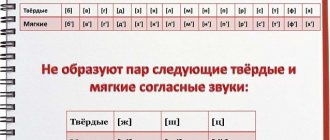
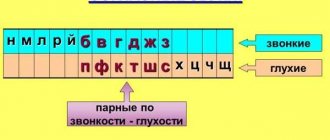
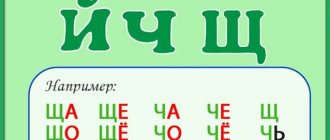
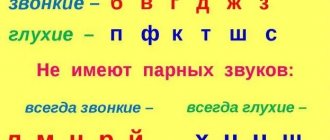
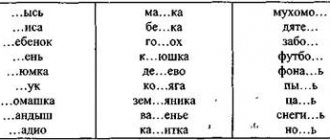
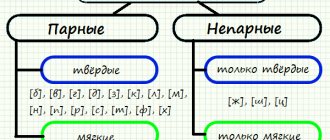
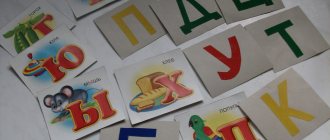
![Sound [Z]](https://lubcentre.ru/wp-content/uploads/zvuk-z-330x140.jpg)
